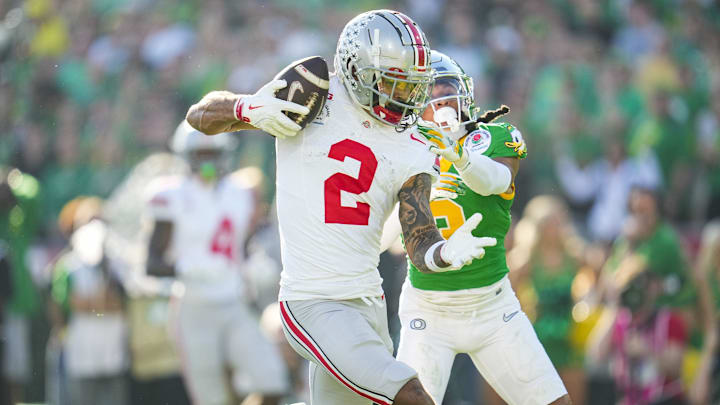There's the blueprint, and then there's the whistle before opening kickoff. Oregon secondary coach Chris Hampton took questions Monday after practice and he said, "I think we've got all the talent to be a really good secondary. Now we've just got to do it."
"I think we're still going to run our system, at the end of the day. Obviously we have guys who fit the profile of what we want, height, weight and speed. We've done a great job recruiting, I think, everyone in the organization."
"We definitely look the part. We're not as experienced. I think everyone knows that."
"We've just got to do it, and continue to grow each and every day. We're going in the right direction."
Oregon's secondary will look a lot different this season than a year ago. A big part of that will be trotting out taller defensive backs.
— Max Torres (@mtorressports) August 5, 2025
Chris Hampton: "I think we've got all the talent to be a really good secondary. Now we've just got to do it." pic.twitter.com/x58FvpQoP2
Legendary Oregon coach Mike Bellotti, the winningest in program history, used to say that football is a game of matchups. That's never more important than it is in the one-on-one, out-on-an-island battles between receivers and defensive backs.
Out there, a matchup disadvantage can cost you a quick six points, haunt you all Saturday.
Giving away size and speed and working backwards, a DB has to knock the ball away or steal it without getting a costly penalty, while doing battle with some of the most elite athletes in sports. Duck fans saw how one-sided those battles can get in the 41-21 loss to the Buckeyes.
Other-worldly talents like 6-3, 215 Jeremiah Smith can take opponents to the limit of what's possible.
Jeremiah Smith was made in a lab pic.twitter.com/GGWIhEAo8C
— Woody (@woodyVSworld) August 1, 2025
It's a bit like bull riding. The defender has to use every bit of his wits, training and instincts to hang on for eight seconds. Fortunately in football it's not quite that long. If Jahlil Florence or Na'eem Offord can cover for five seconds, Matayo Uiagalelei can get to the quarterback.
Last Wednesday at 247Sports, reporter Jared Mack posted the updated heights and weights for the Oregon secondary:
Brandon Finney Jr.: 6-foot-2, 203 lbs.
Theran Johnson: 5-foot-11, 195 lbs.
Trey McNutt: 6-foot, 195 lbs.
Na'eem Offord: 6-foot-1, 195 lbs.
Dorian Brew: 6-foot, 200 lbs.
Jadon Canady: 5-foot-11, 185 lbs.
Dillon Thieneman: 6-foot, 205 lbs.
Aaron Flowers: 6-foot, 208 lbs. (2024 Oregon height/weight: 6-foot, 200 lbs)
Jahlil Florence: 6-foot-1, 195 lbs. (2024 Oregon height/weight: 6-foot-1, 190 lbs.)
Dakoda Fields: 6-foot-2, 200 lbs. (2024 Oregon height/weight: 6-foot-2, 190 lbs.)
Peyton Woodyard: 6-foot-2, 208 lbs. (2024 Oregon height/weight: 6-foot-2, 205 lbs.)
Daylen Austin: 6-foot-1, 199 lbs. (2024 Oregon height/weight: 6-foot-1, 200 lbs.)
Sione Laulea: 6-foot-4, 196 lbs. (2024 Oregon height/weight: 6-foot-4, 190 lbs.)
Solomon Davis: 6-foot, 197 lbs. (2024 Oregon height/weight: 6-foot, 200 lbs.)
Ify Obidegwu: 6-foot-1, 203 lbs. (2024 Oregon height/weight: 6-foot-1, 195 lbs.)
Kingston Lopa: 6-foot-5, 210 lbs. (2024 Oregon height/weight: 6-foot-5, 198 lbs.)
Every returning player has gotten bigger, faster and stronger, a testament to their hard work in the weight room and performance lab. The roster has been upgraded with superior body types. There's extra length and wingspan for special situations, like matching up in the Red Zone.
All but two are at least six feet tall; all but one are at least 195 pounds. Contrast this to last season when the entire starting unit played undersized. "Five absolutely amazing DBs last season that played their butt off, and the tallest guy being 5-10 and a quarter, you just can't respect more what they did for us," defensive coordinator Tosh Lupoi said.
The Ducks will have an entirely new group of starters in the defensive backfield, and that's a supreme coaching challenge. Hampton has to get them working as a team, communicating, adjusting, reading what the offense is trying to do with a hive mind.
That's a particular challenge in the era of the RPO, where the quarterback reads a safety and changes his option depending on how the defender reacts. It puts the defender in a bind.
In the spring Hampton talked about his new wave of talent and potential at the back end of the defense.
Oregon’s 2025 DBs have elite speed + height—perfect for Coach Hampton. Freshmen like Offord, Finney, and Brew bring size and length to a secondary built to dominate. 🦆📈 pic.twitter.com/usylQ3JjJy
— DuckZone503 (@DuckZone503) April 9, 2025
They're bigger, stronger and faster with improved athletic ability, but Hampton's challenge is to get them executing with consistency under pressure, able to stick to playoff-caliber receivers, limit big plays and create turnovers.
The ball skills this group displayed in the Spring Game warrant a lot of optimism, but in 25 days, "the proof's in the pudding," as Dan Lanning likes to say.
That puts a lot of pressure on Hampton, Thieneman, Florence and the rest, but pressure is a privilege.
It helps too that Oregon has a load of talent at receiver, including a handful of guys with 10.4, 10.5 speed and a couple of big bodies like 6-6 Kyler Kasper, 6-3 Kenyon Sadiq, 6-4 Roger Salepaga, and 6-2 Jurrion Dickey. It allows the Ducks to perfect the techniques of leverage and timing they'll need to have a fighting chance in the playoffs.
